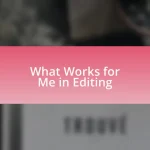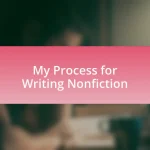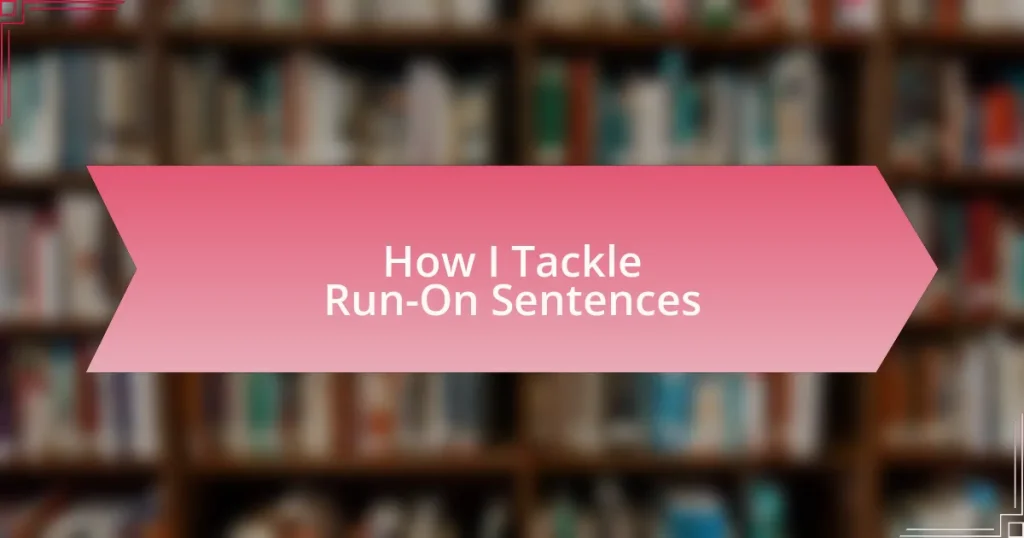Key takeaways:
- Run-on sentences occur when independent clauses are improperly combined, often leading to muddled ideas and a loss of reader engagement.
- Effective techniques to fix run-on sentences include breaking them into shorter sections, using appropriate punctuation, and reading aloud to identify clarity issues.
- Personal strategies for tackling run-ons consist of chunking thoughts, varying sentence lengths for rhythm, and seeking feedback from others for clearer writing.
- Utilizing tools like grammar-checking software, writing communities, and applications like the Hemingway App can significantly enhance sentence structure and overall clarity.
Author: Clara Whitfield
Bio: Clara Whitfield is a captivating storyteller and acclaimed author known for her rich, character-driven narratives that explore the complexities of human relationships. With a background in psychology and a passion for literature, Clara weaves intricate plots that resonate with readers on multiple levels. Her debut novel, “Echoes of the Heart,” received critical acclaim and was a finalist for several literary awards. When she’s not writing, Clara enjoys hiking in nature, experimenting in the kitchen, and engaging with her vibrant community of fellow writers. She resides in Portland, Oregon, where she draws inspiration from the lush surroundings and eclectic culture.
Understanding run-on sentences
Run-on sentences can be quite sneaky, often creeping into my writing without me realizing it. I remember a time when I submitted an important essay, proud of my dense ideas, only to be met with the critique that my sentences were muddled. It was a humbling experience that really made me think: how clear can my writing be if my thoughts aren’t properly separated?
When two independent clauses are improperly combined, that’s when a run-on sentence occurs. I used to struggle with this in my early writing days, thinking longer sentences showed sophistication. Instead, they often muddied my message. Have you ever skimmed through a paragraph only to lose the thread? That’s exactly what run-ons can do—they cause readers to lose focus, making the content less engaging.
Understanding run-on sentences isn’t just about grammar; it’s about clarity. I often find that breaking down my ideas into shorter, more digestible sentences not only enhances understanding but also allows my personality to shine through my writing! It’s a reminder that every word matters and that, at the end of the day, effective communication is key. How do you feel when your ideas are presented clearly versus when they’re lost in complexity? It’s a game-changer, isn’t it?
Identifying run-on sentences
Identifying run-on sentences starts with being aware of how many independent clauses are in a sentence. Once, while drafting a short story, I crafted a sentence that seemed perfectly fine until I reread it and noticed it had three independent ideas jammed together. It struck me—my readers would likely feel overwhelmed, just as I had when reviewing my work. How can we expect clarity if we don’t keep our thoughts organized?
One tip I’ve discovered is to look for conjunctions like “and,” “but,” or “or,” which often mark the boundaries between ideas. I recall a particular blog post where I paired two independent clauses with “and” without a proper pause. It completely derailed the story’s flow. Recognizing these moments has significantly improved my writing; once I began to dissect my sentences, I noticed clarity blossomed, and my writing began to breathe.
It’s also useful to read sentences aloud; the rhythm of speech can reveal awkward constructions. I often catch my own run-ons this way—if I find myself gasping for breath mid-sentence, it’s a strong hint that I need to break things up. Reading aloud engages a different part of my brain, prompting me to hear where the structure falters. Isn’t it fascinating how our ears can sometimes catch what our eyes miss?
Common causes of run-on sentences
When I think about the common causes of run-on sentences, one prominent factor comes to mind: excitement. Sometimes I get so caught up in a thought that I forget to hit the brakes. I remember a time while writing a passionate review of a movie; my sentences started to stretch on and on, reflecting my enthusiasm rather than concise ideas. It’s remarkable how our emotions can influence our writing, often causing us to lose the clarity we aim for.
Another frequent culprit is a lack of punctuation. I’ve caught myself neglecting commas or periods, thinking I could just connect all my ideas fluidly. One day, as I was composing an article about travel, I turned a simple observation into a lengthy run-on by cramming in too much information without pausing. It’s like attempting to juggle multiple balls at once; eventually, something drops. Have you ever tried to cram too much into your writing and found it just didn’t work?
Finally, confusion over sentence structure can lead to run-ons. I once misjudged where one thought ended and another began while I was writing a personal essay. The result was a tangled web of ideas that left even me lost. Sometimes, I think of this as trying to follow a winding path without signs. Once I learned to recognize where my ideas diverged, it became easier to create clearer, more impactful sentences. Isn’t it a relief to discover that clarity can come from just a little intention?
Techniques to fix run-on sentences
One effective technique I often use to address run-on sentences is breaking them into shorter, more digestible chunks. I remember once trying to capture the essence of a complex argument in a single breath, only to lose my reader along the way. By dividing my long sentence into two or three shorter ones, I discovered that not only did my writing become clearer, but it also sounded more engaging. Have you noticed how a simple pause can actually make your ideas resonate better?
Another strategy involves using appropriate punctuation, such as semicolons or conjunctions, to separate related thoughts. I’ve found that a well-placed semicolon can act like a friendly guidepost, directing the reader through my ideas while maintaining a connection between them. There was a time I struggled with this, confusing a semicolon for a mere pause. Understanding its proper use transformed my writing from a chaotic spill to a smooth flow. Have you ever experienced that “aha!” moment when you master a piece of punctuation?
Lastly, I rely heavily on reading my work aloud. This simple practice has highlighted where I lose my breath and clarity, often pointing out run-ons I didn’t catch while writing. I recall reading a piece about my favorite hobby and stumbling over lengthy sentences that left me gasping for air. By hearing the rhythm of my words, I can identify those unwieldy sentences, prompting me to revise them into something clearer and more engaging. Have you ever tried that, and found it changed your perception of your own writing?
Personal strategies for tackling run-ons
When it comes to tackling run-on sentences, I often turn to the strategy of chunking my thoughts into manageable parts. I remember the first time I tried this technique; I was writing a blog post that felt like a marathon without a finish line. Splitting my long sentences into smaller sections not only made my points stand out but also allowed my readers to catch their breath and absorb the information without feeling overwhelmed. Have you ever felt like you were drowning in words while reading?
Another personal strategy I employ is to consciously vary my sentence lengths. Mixing short, impactful statements with longer, more complex ones creates a natural rhythm in my writing. There was a time when I thought that longer sentences meant better writing, but I learned that brevity often packs a punch. I distinctly recall a colleague pointing out my tendency to ramble, and that moment shifted my perspective entirely—now I relish the art of concise expression. Does your writing have a rhythm, or is it more like a continuous hum?
Finally, I find that asking for feedback can illuminate those sneaky run-on sentences that I might miss myself. A trusted friend once took the time to review my work and highlighted a few sentences that, although they felt fine to me, had lost their clarity. That experience opened my eyes to the importance of an external perspective. It’s fascinating how a fresh set of eyes can catch what I’ve overlooked. Have you ever considered how someone else’s point of view could enhance your writing?
Tools for improving sentence structure
One tool I frequently rely on is grammar-checking software. I remember the first time I used one; it was like having a writing tutor by my side. The software marked my run-on sentences and even suggested ways to break them up, which was incredibly eye-opening. Have you ever felt amazed by how technology can enhance your writing skills?
Another effective resource is online writing communities. When I joined one, I shared a few pieces I had been struggling with, expecting minimal feedback. To my surprise, other writers offered constructive criticism specifically targeting my sentence structure. Their diverse insights taught me that different perspectives can reveal patterns I hadn’t noticed. Do you participate in any writing groups that could help you refine your style?
Lastly, I can’t recommend tools like the Hemingway App enough. It gently prompts writers to simplify their sentences, making the text more readable. When I first started using it, I found myself reevaluating my word choices and structures in ways I hadn’t before. It felt refreshing to transform dense paragraphs into punchy statements that truly resonated. How do you approach editing your own work for clarity?















